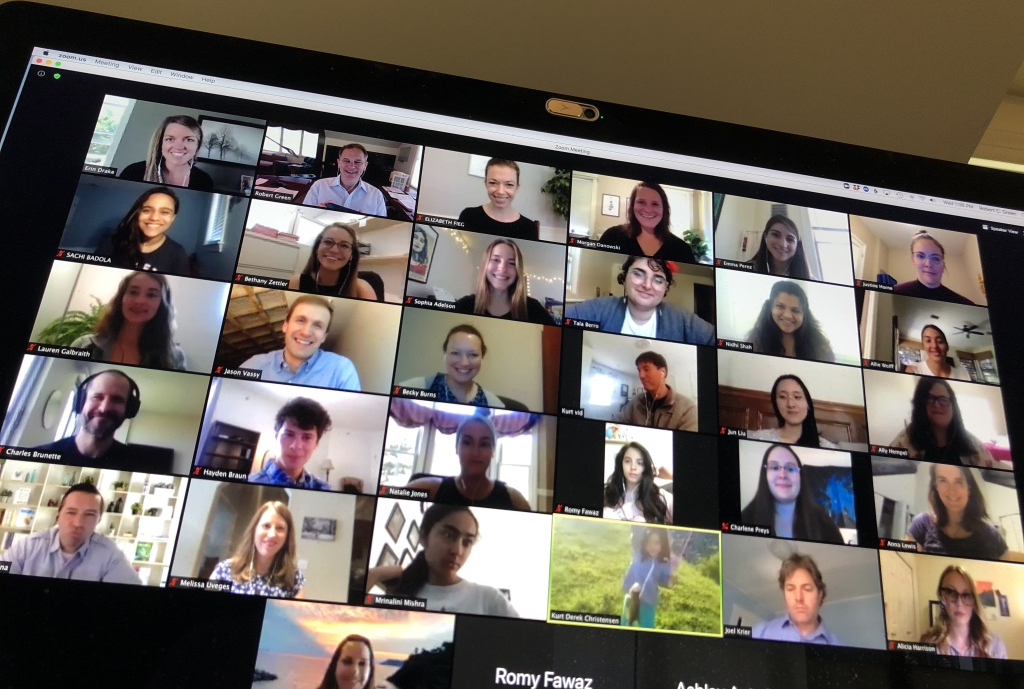Staying Apart, Working Together: Some Staff Transition to Remote Work

Staff from the Genomes2People research program host a lab meeting over Zoom.
For more than 3,700 staff throughout the Brigham, office and home life merged on March 13, when the organization announced that all employees who could effectively perform their jobs remotely should do so, starting the following week.
Implemented in response to a directive from Gov. Charlie Baker — who had asked employers to help to slow the spread of COVID-19 by quickly transitioning their office workers to remote work — the move marked a new chapter for many teams across the Brigham.
“We announced it on a Friday and essentially enacted it the following Monday. That’s amazing for a workforce of this size,” said Paula Squires, MBA, SHRM-SCP, SPHR, senior vice president of Human Resources. “On top of that, we were all responding to the crisis at hand. It was a lot of transition in a very short time, and it has been incredible to see how quickly staff adapted.”
As schools and nearly all child care services remained closed during the pandemic, remote work presented challenges for working parents, who did their best to juggle their dual roles as parents and professionals.
“As a mother of two young children, I learned that you have to give yourself a lot of patience and grace,” said Erin Drake, director of research operations for Genomes2People, a translational research program within the Division of Genetics. “If we’re on a Zoom call and a toddler’s head pops into someone’s screen, we power through it or let that person know it’s OK to turn off their video for a few minutes and reconnect when they can.”
Despite the many challenges of working from home — from video call fatigue to the feeling of being always “at work” — remote staff remained dedicated and diligent throughout the pandemic, making essential contributions to the Brigham’s COVID-19 response. And even after the height of the crisis passed, thousands of staff members continued to work remotely to support the hospital’s safe care commitment by limiting on-site density and encouraging physical distancing.
New Dynamics
Although departments that adopted remote work represented a diverse range of roles and activities, they shared two important ingredients for success: teamwork and technology.
Drake said her team had to think creatively about how to continue their work after going fully remote.
“Many of our research projects involve human participants, and several came to a screeching halt due to the pandemic,” she said. “We put a lot of effort into figuring out how some work could be accomplished virtually, such as mailing genetic testing kits and coordinating how to receive them back if we couldn’t be in the office.”
While many of the program’s activities were disrupted, the team found ways to build and maintain momentum in other important areas, such as identifying new research projects, working on new grant applications and publishing prior work. Researchers affiliated with the program also pivoted to remotely contribute to two unfunded studies involving the role of genetics in COVID-19.
Among those who adapted to remote work were the Human Resources (HR) staff, a department comprising about 80 people spread across several specialized teams. From new hire orientation to recruitment for critical job openings to Employee Assistance Program services, nearly all HR operations had to switch to a remote model.
HR staff, in conjunction with Mass General Brigham HR colleagues, also adapted to new ways of working while supporting some of the Brigham’s most urgent workforce needs during the pandemic.
HR staff remotely managed the new Labor Pool and reassigned employees; managed recruitment, emergency on-boarding and orientation; provided support for child care and housing services; helped support multilingual staff; and created virtual support programs for staff via the Employee Assistance Program and the Office of Mediation, Coaching, Ombuds and Support Services. Occupational Health remotely conducted COVID-19 exposure tracing.
“The nature of my work changed,” said Gina DiCarlo, a senior HR business partner supporting several departments, who transitioned to remote work. “I became mainly focused on pandemic necessities, such as ADA accommodations and supporting my groups as they navigated through the impact of COVID-19.”
Bridging the Gap
Remote staff relied heavily on video conferencing and online collaboration software, including Microsoft Teams and Zoom, to stay connected and productive.
“Our HR Business Partner group has virtual daily huddles and weekly business meetings, as well as ad hoc Zoom meetings,” DiCarlo said. “Our department leadership also held weekly Zoom meetings with the team, so we always felt very connected and well-informed.”
Technology also helped remote teams maintain some of the social atmosphere of working in an office.
“Every Monday, we have a group check-in over Zoom for our core team. It’s less focused on our research and more of a morale check-in to support each other and talk about what we and our families are going through,” Drake said. “We have a couple of colleagues who live alone, so we want them to know they have another support network. We do a wellness check to make sure we’re all healthy and safe.”
While staying apart sometimes still felt isolating, DiCarlo said her connection to the Brigham family has remained strong, even from afar.
“I miss being in the heart of the action. I feel like it’s easy to still be effective remotely, but I found myself wanting to be on campus and be part of the energy,” DiCarlo said. “Every time I saw one of our medical professionals interviewed in the media, or saw one of our innovations on the news, a wave of pride came over me. It’s really a privilege to be part of this team.”

Leave a Reply